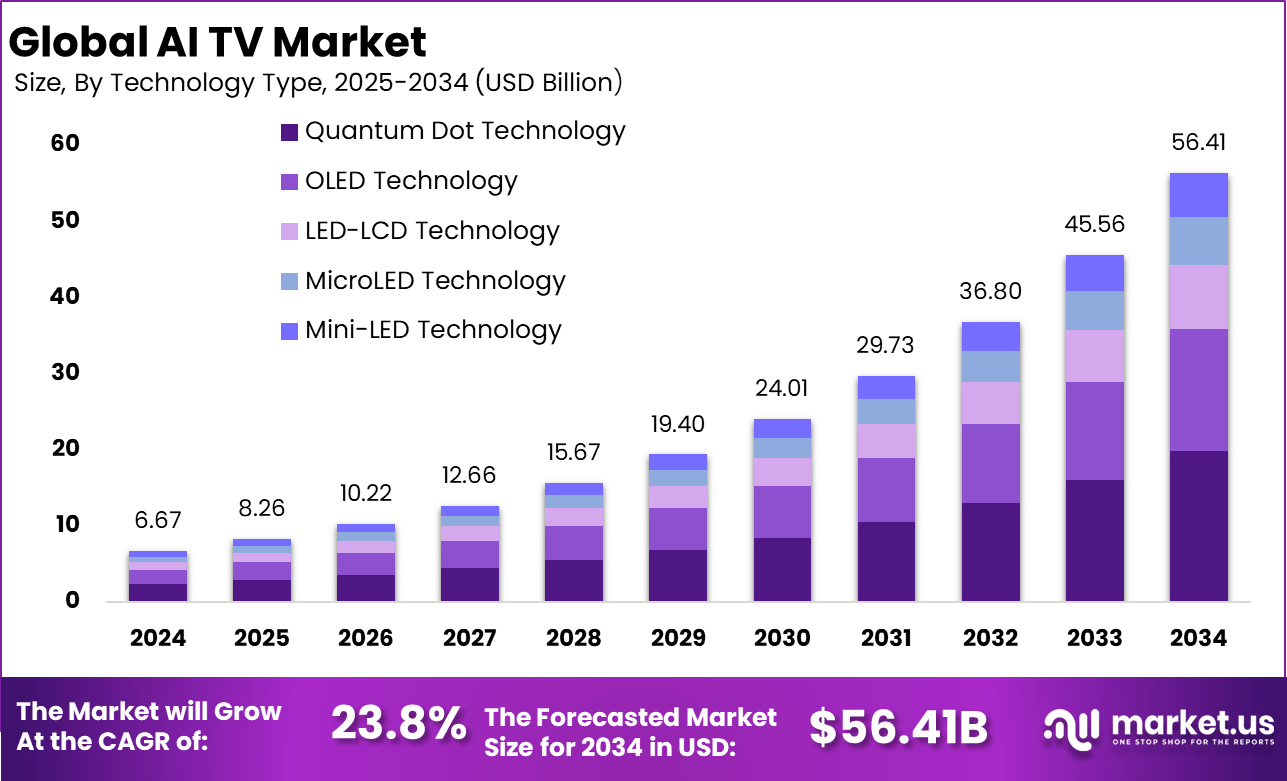Table of Contents
Introduction
The Global AI TV Market, valued at USD 6.67 billion in 2024, is expected to reach USD 56.41 billion by 2034, growing at a strong CAGR of 23.8%. This rise is driven by advancements in AI-driven picture enhancement, voice recognition, personalized content recommendations, and smart home integration. North America dominated the market in 2024, capturing 32.4% of global revenue with USD 2.16 billion. Increasing adoption of connected devices, rising demand for immersive entertainment, and rapid improvements in display technologies are accelerating the growth trajectory.

How Growth Is Impacting the Economy
The expansion of AI TVs is positively influencing economic development by creating high-value opportunities in semiconductor manufacturing, content streaming ecosystems, AI software development, and internet infrastructure. Investments in neural processing units, advanced display panels, and home automation platforms support employment in engineering, R&D, and consumer electronics manufacturing.
AI TVs enhance digital consumption patterns, driving growth in OTT subscriptions, targeted advertising, and cloud-based content delivery. As households adopt intelligent entertainment systems, local economies benefit from rising consumer spending and smart home expansion. The global shift toward AI-enhanced entertainment also improves competitiveness among device manufacturers, stimulating innovation and boosting trade across electronics supply chains.
➤ Smarter strategy starts here! Get the sample – https://market.us/report/ai-tv-market/free-sample/
Impact on Global Businesses
Businesses experience rising costs due to advanced chipsets, AI processors, premium OLED/QLED panels, and enhanced audio technologies. Supply chains are shifting as companies diversify semiconductor sourcing and integrate AI modules into manufacturing workflows. Sector-specific benefits include improved content delivery for streaming platforms, better consumer analytics for advertisers, enhanced visualization for gaming companies, and smarter hospitality TV systems. Retailers gain from higher margins on premium smart TVs but must manage inventory complexity linked to rapid model upgrades.
Strategies for Businesses
Businesses should strengthen AI-driven content personalization, invest in edge-AI processing for real-time optimization, and form partnerships with OTT providers and smart home platforms. Diversifying suppliers, enhancing cybersecurity features, and improving interoperability with IoT ecosystems will ensure long-term competitiveness. Companies should also prioritize energy efficiency, user privacy, and localized AI models to enhance market differentiation.
Key Takeaways
- Market projected to reach USD 56.41 billion by 2034
- Strong CAGR of 23.8% driven by AI-enhanced viewing experiences
- North America leads with 32.4% revenue share
- AI TVs boost personalization, automation, and content-driven revenue
- Growing adoption across smart homes, gaming, hospitality, and OTT
➤ Unlock growth secrets! Buy the full report – https://market.us/purchase-report/?report_id=161335
Analyst Viewpoint
The AI TV market is rapidly evolving as AI-enhanced processors significantly improve performance, energy efficiency, and user interaction. Present growth is driven by demand for intelligent content recommendations, voice assistants, and superior picture processing. Over the next decade, AI TVs will integrate multimodal AI, immersive sound modeling, and advanced sensor-driven personalization. Wider affordability and maturing smart home ecosystems are expected to expand adoption in emerging economies. The long-term outlook remains strongly positive.
Use Case and Growth Factors
| Use Case | Growth Factors |
|---|---|
| Personalized content recommendations | Increased OTT consumption and AI advancements |
| Smart home integration | Growing IoT adoption and connected living trends |
| AI-enhanced picture and sound processing | Demand for premium visual experience |
| Gaming optimization | Rise in cloud gaming and next-gen consoles |
| Hospitality smart TV systems | Growth in tourism and digital guest experiences |
Regional Analysis
North America leads the market due to strong adoption of smart home technology, high consumer spending, and early availability of premium AI-enabled TVs. Europe follows with rising demand for energy-efficient displays and strong OTT penetration. Asia Pacific is the fastest-growing region, supported by large-scale electronics manufacturing, rapid urbanization, and increasing middle-class adoption. Latin America and the Middle East are gradually expanding AI TV integration as digital infrastructure and broadband accessibility improve.
➤ Want more market wisdom? Browse reports –
Business Opportunities
Significant opportunities lie in AI-optimized display processors, cloud-powered content engines, gesture-controlled interfaces, voice AI, and home automation connectivity. Companies can expand into luxury hospitality TV systems, AI-driven gaming displays, regionalized content recommendation engines, and energy-efficient smart TVs. Growth potential is strong in emerging markets with rising internet penetration and growing interest in AI-driven home entertainment.
Key Segmentation
The AI TV market includes segments such as 4K AI TVs, 8K AI TVs, OLED AI TVs, QLED AI TVs, and budget AI-powered smart TVs. Applications span residential home entertainment, gaming, hospitality, retail displays, and smart home integration. Core technologies include neural processing units, voice AI systems, AR-enabled overlays, adaptive sound engines, and real-time picture enhancement models. Deployment channels include online retail, specialty electronics stores, and telecom/OTT partnerships.
Key Player Analysis
Market participants focus on developing advanced AI processors, improving display quality, and strengthening integration with smart home ecosystems. Companies are enhancing personalization algorithms, expanding OTT partnerships, and innovating in energy efficiency. Strategies include diversifying supply chains, investing in R&D, and improving voice-AI capabilities. Competitive advantage is shaped by ecosystem connectivity, software updates, and advanced picture optimization technologies.
- TCL
- LG Corporation
- Sony
- Samsung Electronics Co. Ltd
- Haier
- Xiaomi
- PHILIPS
- Skyworth
- Toshiba Corporation
- Hisense
- Changhong
- Other Major Players
Recent Developments
- April 2024: Launch of next-gen AI picture processors for ultra-clear viewing.
- June 2024: Integration of advanced voice assistants into premium smart TV models.
- September 2024: Expansion of 8K AI TV lineups for global markets.
- January 2025: Introduction of AI-driven gaming optimization engines.
- March 2025: Partnerships formed with leading OTT platforms for personalized streaming.
Conclusion
The Global AI TV Market is transforming home entertainment through advanced AI capabilities, personalized content, and smart home integration. With strong technological progress and rising global demand, AI TVs are set to become central to future digital living environments.
Discuss your needs with our analyst
Please share your requirements with more details so our analyst can check if they can solve your problem(s)



